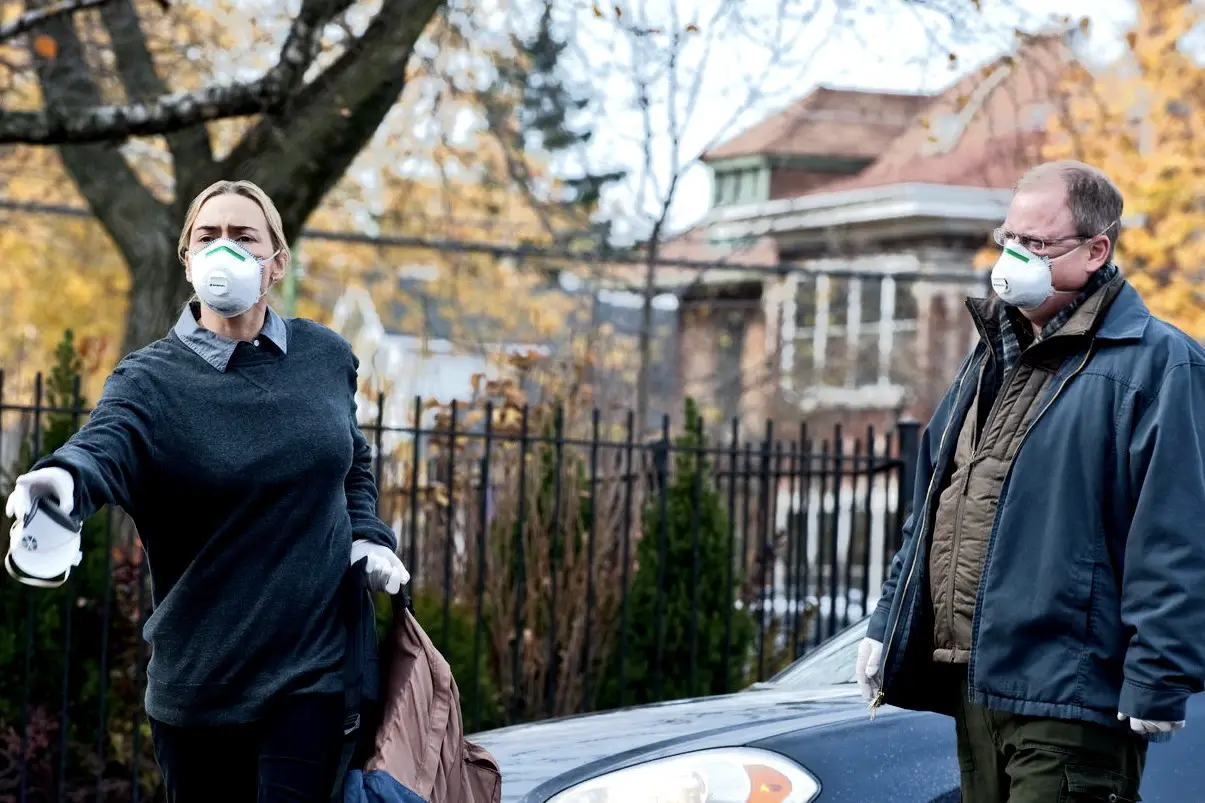I first watched “Contagion” earlier this year as required viewing for an anthropology essay about how anthropologists would deal with an epidemic; I was appropriately terrified. The COVID-19 epidemic was confined to Wuhan initially, and due to the apparent distance from China to the U.S. and Europe, many people continued their everyday lives as usual.
Every shot of Steven Soderbergh’s 2011 thriller proved any perceived distance or safety to be merely illusory. Everything about the film, from its simple title to the camera’s lingering focus on objects touched by infected characters — credit cards, bus rails, door handles and even each other — emphasized the speed and ease at which a deadly virus can spread across the world unnoticed.
“Contagion” was created in consultation with epidemiologists and public health officials of the CDC and the WHO, and it was praised as a scientifically accurate depiction of a global pandemic that opted for proper science instead of Hollywood simplicity or glamor. For this reason, it seemed to be a prophetic portrayal of what our future with COVID-19 would look like.
Like its tagline, “Nothing spreads like fear,” it struck a chord with my already-brewing panic, which worsened with every glance at the daily increase of cases. It acted as a reminder of humanity’s proximity to viral pandemics. Guided by the preventative measures taken in the film, I began taking precautions against COVID-19.
I used hand sanitizer when getting on and off the bus; at college, I washed my hands wherever I could and opened doors with my sleeve. I stopped going to the movies. The film’s unflinchingly gruesome portrayal of brain swelling, hacking coughs and corpses whose mouths were coated in foam were enough to prompt several “what if” questions about COVID-19, and it quelled any niggling doubts I had about my precautions.
What Did the Film Get Right?
What if this happened here? What if one carrier of the virus flew back from China and inadvertently infected thousands of people? In the early stages of our global crisis, I looked to “Contagion” as a blueprint of sorts for how to deal with COVID-19.
Clearly, I was not alone in my preoccupation with the film, with rentals of the 2011 thriller soaring on Amazon Prime Video and iTunes, even reaching the Top 10 on the latter between January and March of this year.
The newfound relevance of a 10-year-old film was similarly appreciated by all corners of the internet. Average conspiracy theory-inclined Twitter users have claimed “Contagion” predicted the coronavirus, and Barry Jenkins, writer and director of the Oscar-winning film “Moonlight,” watched the movie wanting to compare it to our current situation; he concluded that it felt like a “documentary,” which scared him.
Filmmakers and film viewers alike were prompted to watch Soderbergh’s film out of morbid curiosity, in order to seek out similarities between the film’s fictitious MEV-1 virus and our own COVID-19.
Whether they were watching “Contagion” as a confirmation of their worst fears in its depiction of a virus that ravaged the world by killing 27 million people worldwide, or for its hopeful ending, people looked to the film for a mirror of reality and found an eerily apt reflection of our own pandemic.
Shortly after the WHO announced a global pandemic, the U.K. and the rest of Europe were put under lockdown, and multiple states in the U.S. issued stay-at-home orders. The terrifying events depicted in “Contagion” became our reality.
Previously unused terms, such as social distancing and quarantine, became part of our daily vocabulary. People started wearing masks and were told to stay six feet apart from one another. Families weren’t able to say goodbye to their dying loved ones.
Frontline workers put their lives at risk. An untested and dangerous miracle cure was promoted, not by a conspiracy theorist blogger as in the film, but by the president. The scientific and governmental response depicted in “Contagion” is quite similar to the COVID-19 response.
What Did the Film Get Wrong?
Despite the commonalities, “Contagion” doesn’t capture the more mundane parts about life during a global pandemic. Although screenwriter Scott Z. Burns wanted the virus depicted in the film to be “the result of life on Earth in its most mundane,” the film’s adherence to the thriller genre muffles these intentions.
Using the glossy multi-narrative format, the film follows a number of characters in an attempt to capture the scope of a pandemic: Dr. Leonora Orantes, Dr. Erin Mears, Dr. Ellis Cheever, scientist Ally Hextall, conspiracy theorist blogger Alan Krumwiede and Matt Damon’s Mitch Emhoff.
This is where “Contagion” falters in its portrayal of life during a pandemic. All of these characters are different, but what they have in common is being in a constant state of action. The uber-realistic “Contagion” is held back by its superficial Hollywood action movie sensibilities.
Despite trying to ground itself in the archetypal everyman Matt Damon character, a man who wants to protect his daughter from the virus that claimed his wife and stepson, the film doesn’t show the average pandemic life.
Instead of seeing meaningless attempts to make banana bread or dalgona coffee, or pointlessly lazing around watching TV, we see the frantic kidnapping of WHO epidemiologist Orantes and the heroic development of a vaccine by Hextall. By placing all its faith in authority figures, “Contagion” ignores the more ordinary members of society.
Although it was hailed as an accurate representation of a pandemic by public health experts and scientists upon its release, “Contagion” only touches on the panic, prevention and tragedy of a pandemic, pinpointing its narrative focus on the early stages of the outbreak and the creation of a vaccine.
It doesn’t show what it’s like in the in-between stage of being confined to your house. For the most part, that’s because its characters do not stay inside. They rush around crowded hospitals, research labs, restaurants and offices, all while trying to save the world.
Even though teenage Jory complains about losing the seasons while stuck inside (“Why can’t they invent a shot that keeps time from passing?”), the film doesn’t show the stasis, the waiting period, of your world being confined to your house and the internet.
The narrative jumps from Day 31 of the pandemic to Day 133 and the distribution of a vaccine, neatly omitting all the dull indoor activities, which we are all familiar with by now — failed baking attempts, binge-watching movies and TV shows, attempting to learn a language and starting a new hobby.
“Contagion” also fails to prophesize the positive ways people adapt to pandemic life, both socially and culturally. The film restricts its portrayal of sociology to scenes of panicked shoppers shoving past one another in an attempt to gain the miracle cure forsythia or people burning down buildings.
Aside from its slightly melancholic penultimate scene of Mitch staging a two-person prom for his daughter with her recently vaccinated boyfriend, Soderbergh’s film didn’t predict the extent to which people positively acclimate to crisis with the help of modern technology.
In our current society, plays, operas and ballets are now accessible to wider global audiences via online streaming. Exercise classes are held via Zoom, as are virtual pub quizzes, game nights and group movie marathons. In a recent interview with the Los Angeles Times, the movie’s meticulous screenwriter, Burns, even admitted to leaving out such sociological behavior: “It’s been fascinating to see the aspects of this narrative play out that we didn’t think about … there’s a lot of really fascinating human behavior that we didn’t even think about when we were doing this.”
When I first watched “Contagion,” I was terrified; I didn’t know what life in a pandemic would be like — if there was any life at all. Taking Soderbergh’s film as a prophecy or blueprint meant I thought a pandemic would play out in one of two ways: catching the deadly virus and dying, or being miserably confined to my home.
Now, after rewatching the 2011 film and having experienced a pandemic, besides the eerie parallels we can draw between the film and our own situation, I have realized that “Contagion” is only a prediction of COVID-19 as far as scientific accuracy and worst-case scenarios are concerned. When it comes to the more light-hearted sociological adaptations people make for a pandemic, we should remember that “Contagion” is, after all, a fictional Hollywood thriller from the last decade.

















